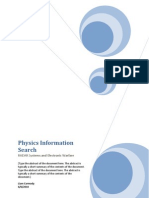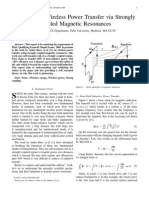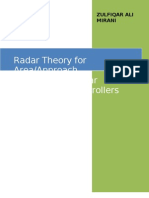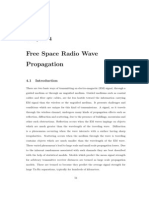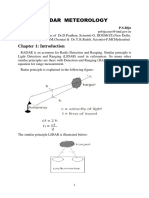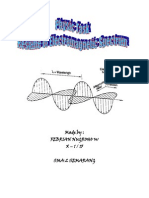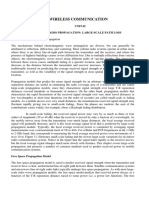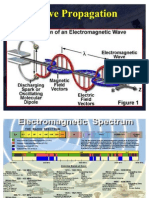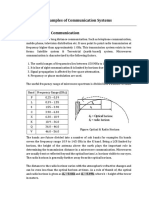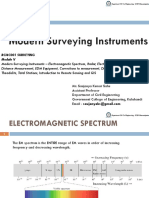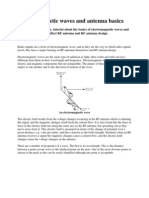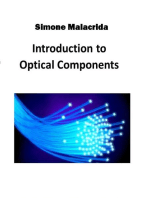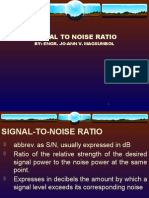Microwave Communications and Radar: Target Scattering Cross-Section
Microwave Communications and Radar: Target Scattering Cross-Section
Uploaded by
Omotowa DapoCopyright:
Available Formats
Microwave Communications and Radar: Target Scattering Cross-Section
Microwave Communications and Radar: Target Scattering Cross-Section
Uploaded by
Omotowa DapoOriginal Title
Copyright
Available Formats
Share this document
Did you find this document useful?
Is this content inappropriate?
Copyright:
Available Formats
Microwave Communications and Radar: Target Scattering Cross-Section
Microwave Communications and Radar: Target Scattering Cross-Section
Uploaded by
Omotowa DapoCopyright:
Available Formats
2/26
6.014 Lecture 14: Microwave Communications and Radar
A. Overview
Microwave communications and radar systems have similar architectures. They typically process the signals before and after they are transmitted through space, as suggested in Figure L14-1. Conversion of the signals to electromagnetic waves occurs at the output of a power amplifier, and conversion back to signals occurs at the detector, after reception. Guiding-wave structures connect to the transmitting or receiving antenna, which are generally one and the same in monostatic radar systems. We have discussed antennas and multipath propagation earlier, so the principal novel mechanisms we need to understand now are the coupling of these electromagnetic signals between antennas and circuits, and the intervening propagating structures. Issues we must yet address include transmission lines and waveguides, impedance transformations, matching, and resonance. These same issues also arise in many related systems, such as lidar systems that are like radar but use light beams instead, passive sensing systems that receive signals emitted by the environment either naturally (like thermal radiation) or by artifacts (like motors or computers), and data recording systems like DVDs or magnetic disks. The performance of many systems of interest is often limited in part by our ability to couple energy efficiently from one port to another, and our ability to filter out deleterious signals. Understanding these issues is therefore an important part of such design effors. The same issues often occur in any system utilizing high-frequency signals, whether or not they are transmitted externally.
B.
Radar, Lidar, and Passive Systems
Figure L14-2 illustrates a standard radar or lidar configuration where the transmitted power Pt is focused toward a target using an antenna with gain Gt. At range r [meters] the radiated intensity at the target It is: It = GtPt/4r2 [Wm-2] (1)
Some part of this is scattered by the target and received again at the radar. We define the target scattering cross-section s as the cross-section [m2] that would produce the observed echo strength if the scattering were isotropic. That is, the scattered intensity sensed back at the radar Ir is: Ir = It s/4r2 [Wm-2] (2)
-1
2/26
The power received by the radar Pr [W] is then: Pr = Ar Ir = Ar (GtPt/4r2)(s/4r2) = Ar GtPts/(4r2)2 where Ar [m2] = Gt2/4 is the effective area of the receiving antenna. Therefore, Pr = Pt s (Gt/4r2)2/4 [Watts] (4) (3)
This is one form of the radar equation. If atmospheric attenuation due to water vapor, rain, or other causes is important, then its round-trip effects must also be added to (4). It is important to note that the scattering cross-section s approximates the physical cross-section of the target if the target is large compared to a wavelength and scatters the incident radiation roughly isotropically with little absorption. If the target absorbs the radiation or scatters it preferentially in directions other than the receiver, then s is smaller. If, however, the target scatters the radiation preferentially toward the transmitter, then s can be substantially larger than the physical cross-section. For example, metallic corner reflectors on boats are designed to enhance their radar crosssection so they can be more easily seen and avoided by other ships at sea. Corner reflectors comprise three flat mirrors that make a corner at right angles, so that the reflected ray retraces the path of the incident ray (because of geometry and the fact that the angle of incidence equals the angle of reflection).
Typical radars measure the strength of echos, their round-trip travel time (which indicates range), and their Doppler shift (which indicates target velocity toward the radar). A simple example is given in L11-3, where we assume a powerful radar is looking for killer asteroids that could wreak havoc on Earth. The problem is to determine the maximum range at which an echo could be detected above the thermal noise that typically dominates microwave systems looking out toward space. In this example, the transmitter power is one megawatt (very large), the radar antenna gain is 108 (also very large), the wavelength is 10 cm, the assumed asteroid scattering cross-section is 104 [m2], and the required received power is the same as the thermal noise power within the same bandwidth, kTsB watts, where k is Boltzmanns constant (~1.3810-22), Ts is the system noise temperature (sometimes comparable to its physical temperature), and B is the signal and system bandwidth in Hz. The example assumes the system noise temperature is 10K, which is excellent, and that the system bandwidth is one Hertz, which is quite narrow. Solving the radar equation (4) for range r, we find that it is ~4107 km, or roughly one third the distance from the Earth to the sun (called an Astronomical Unit, or A.U.). If the closing velocity between the asteroid and Earth approximates the velocity of the Earth in its orbit about the sun, then this corresponds to approximately 2 or 3 weeks warning. Modern optical systems could give still earlier indications, and so they are currently the detection means of choice.
-2
2/26
Slide L14-3 also presents an example involving detection of a thermal target that simply emits detectable black-body radiation in proportion to its physical temperature To. Any communications or radar system constantly receives such radiation from the environment in proportion to the average temperature of the scene it is viewing. Thus a satellite communications receiver viewing a ground station would receive thermal radiation from the earth in accord with the average temperature of the terrain near that ground station, so To might be 270K, for example. Since this is large compared to the noise typically contributed by the receiver itself, environmental thermal noise often dominates such communications links. Because receivers that measure incident power can average much data, their rms sensitivity can be impressive. For example1, a receiver measuring the average power in a signal of B Hz bandwidth might sample that signal at 2B samples/second (the Nyquist rate), and then average for seconds, yielding 2B independent measures of signal power. Averaging independent power measurements reduces the uncertainty by the square root of the number of samples averaged. If we wish to measure the temperature of 300K terrain with a receiver having a noise temperature of 200K, the total noise temperature Ts (noise power = kTs Watts/Hz) is 500K and the rms sensitivity of the receiver is then approximately 500/(B)0.5. A typical averaging time might be one second, and the bandwidth might be 100 MHz. In this case the rms sensitivity would be (500/1108)0.5 = 0.05K, a tiny fraction of the 300K signal of interest. Such systems in earth orbit currently measure average atmospheric temperatures with accuracies of hundredths of a degree and are quite sensitive to global warming trends. Medical applications have also been developed.
C.
Guided Waves
Slide L14-4 suggests the most common ways radio or optical signals are conveyed from point to point, other than in TEM structures such as those discussed in Lecture 12. First, waves can propagate in free space, and can be launched and intercepted using antennas. Such waves can also be bounced back and forth between flat conductors as illustrated in L14-4A, although if the wavelength is too long (>d/2) compared to the plate separation d, the wave decays rather than propagating. This structure is called a parallel-plate waveguide. This bouncing method also works inside rectangular waveguides, where the waves bounce both vertically and horizontally, again limited by the requirement that be sufficiently small relative to the waveguide dimensions. Several different propagating wave patterns are possible in waveguides, each of which is called a waveguide mode. These modes can be considered to be standing wave patterns in the lateral dimension, while they propagate longitudinally up or down the waveguide. Each mode has its own minimum frequency of propagation, called the cutoff frequency.
This example is presented for illustration only, and not for mastery.
-3
2/26
Waves bounce well not only off metal walls, but also when they are inside dielectric slabs and are incident upon the air interface at angle i beyond their critical angle c, as suggested in Figure L14-4B. Such guides are called dielectric-slab waveguides. Dielectric waveguides for guiding light are cylindrical and are called optical fibers. Their wave-trapping mechanism is the same as for dielectric slab waveguides, except that the field solutions are Bessel functions rather than sines, cosines, and exponentials.
D.
Impedance and Impedance Transformations
If we represent voltages and currents at frequency on any transmission line by the phasors V(z) and I(z), then we can define the complex impedance Z(z) = V(z)/I(z) ohms (5)
where z is position along the line. In the case of waveguides or optical fibers, which do not have voltages or currents per se, we equivalently speak of electric and magnetic field strengths instead, and the same impedance transformation processes occur. We shall focus first on TEM lines because of their relative simplicity. We define, in the same format as before, v(t) = Re{V ejt}, i(t) = Re{I ejt} (6)
and note that, as in the case of uniform plane waves, we generally have both forward- and backward- propagating waves superimposed on the line. The total voltage and current can then be described as: V(z) = V+e-jkz + V-e+jkz [volts] I(z) = Yo (V+e-jkz - V-e+jkz) [volts] (7) (8)
where the characteristic line admittance Yo = (L/C)0.5 Siemens (ohm-1), as before; L and C are the line inductance and capacitance per meter, respectively. The minus sign in the current expression (8) is appropriate because if V- is positive for a backward propagating wave, then the current corresponding to it (-YoV-e+jkz) must flow in the z direction. It follows from (7) and (8) that the effective impedance (which is usually not the characteristic line impedance Zo = Yo-1) is: Z(z) = Zo(V+e-jkz + V-e+jkz)/ (V+e-jkz - V-e+jkz) = Zo(1+(z))/(1-(z)) where (z) is the complex reflection coefficient, defined as: (z) = (V-/V+)e2jkz (10) (9)
-4
2/26
The behavior permitted by (9) is not immediately obvious, and will be discussed later. One interesting simple result is that if any transmission line is losslessly terminated, for example by a short or open circuit, then Z(z) = jX, where X can be any positive or negative real number depending on the distance from the line termination. This ability to obtain any desired reactance (at a single ) gives us the ability to build complex resonating and tuning circuits using only transmission lines. Since transmission lines can be printed on integrated circuits like any other wires over insulators, this capability is significant. Another important example is our ability to take an arbitrary circuit, such as the one illustrated in Figure L14-5, and match the source to the load so that all the available power from the source is dissipated in the load without reflections (i.e. V- is zero). In this case we have an arbitrary RL load, and add a purely reactive lossless element such as the capacitor C or a different inductor L at a well chosen distance from the load to obtain a match. We can also match the load by inserting before the load a segment of transmission line that has a different well chosen characteristic impedance and length. E. Junctions and Modal Coupling
Where transmission lines meet we have a junction, as illustrated in Figure L14-6. This occurs, for example, at junctions between waveguides and antenna feeds, different waveguides, and coaxial cables and waveguides. They also occur in optical or microwave integrated circuits, where the guides also have juctions with active elements. At these junctions the electric and magnetic fields store energy. If the time average electric energy at a junction exceeds the time average magnetic energy, then we have the equivalent of a parasitic capacitance; if the energy balance is reversed, then we have a parasitic inductance. These parasitic reactances can be tuned out as suggested in Section D above. The number of electromagnetic junctions can be greater than the number of physical junctions. That is, a single waveguide can propagate energy in more than one mode, where each waveguide mode typically has its own characteristic impedance and phase velocity. When two such guides join, every mode can couple energy to every other mode, so such junctions can be characterized by scattering matrices S that reveal the changes in magnitude and phase that occur for every possible input-output modal combination. These S are related 1:1 to impedance matrices Z. In practice we generally design such junctions so that each guide at all frequencies of operation propagates only one mode. Alternatively the junction is designed so that each undesired mode is orthogonal to all other modes and to the junction symmetry so that it cannot be excited. We shall not further address these matrices or this more complex case. F. Resonance and Resonators
The most familiar resonators are those comprising a resistor R, capacitor C, and inductor L. If these three elements are placed in series, as suggested in Figure L11-7,
-5
2/26
then at resonant frequency o = (LC)-0.5 the reactance of the inductor jL cancels the reactance of the capacitor 1/jC when they are added, so that the total impedance of the series combination is just the resistance R. As approaches infinity, so does the impedance of the inductor, and as approaches zero, the impedance of the capacitor now approaches infinity. Thus |Z()| has a minimum at = o, as illustrated. If R, L, and C are connected in parallel, the admittance of the combination approaches R-1 at = o because the admittance of the inductor 1/jL cancels that of the capacitor jC when they are added. The maximum impedance of this parallel resonator is R, and it approaches zero as is increased or decreased, as illustrated. The width of the resonance depends on the relations between R, L, and C (see Figure L11-7A). As R diminishes, this width [radians s-1] also diminishes, and the quality Q of the resonance increases, where Q = o/. All isolated resonances can be well characterized by o, , and R at o. If such a resonator is connected to the end of a TEM transmission line as illustrated, then its impedance R at resonance may or may not match Zo, the characteristic line impedance. If it does match at o, we say the resonator is critically coupled and it absorbs all the incident energy. Most transmission lines in circuits can also exhibit resonances at certain frequencies. For example, consider the TEM resonator illustrated in L14-7, which is short circuited at one end and open circuit at the other. Since propagating waves can not escape from the line, the amplitudes of monochromatic waves moving right must equal those of the waves moving left, and we have perfect standing waves. At certain positions along the line there will be voltage nulls, and at other positions there will be current nulls. Clearly there must be a current null at the open-circuited end and a voltage null at the short circuit. These constraints limit the wavelengths that can exist in this structure. For example, as illustrated, the complex voltage |V(z)| on the line must be zero at the left end and maximum at the right. A resonant frequency in this case has any wavelength n that satisfies the equation: n = 4D/(2n-1), n = 1, 2, 3, (11)
where D is the length of the TEM line. That is, the length of this line D must be an odd number of quarter wavelengths n/4. The corresponding resonance frequencies are fn = c/n Hz The same considerations suggest that the resonant wavelengths for TEM lines open-circuited or short-circuited at both ends would be n = D/n where n = 0, 1, 2, corresponding to fn = nc/D Hz. The value n = 0 corresponds to zero frequency, which is indeed a resonant frequency in these two cases. An open-circuited line can store energy at zero frequency by simply having a static voltage between the two wires, and a shortcircuited line can store magnetic energy by having a constant current flowing around the loop through the two wires.
-6
You might also like
- Radar Theory For Area Approach Radar ControllersDocument38 pagesRadar Theory For Area Approach Radar ControllersMegheDhakaRodNo ratings yet
- Introduction To CSAMTDocument7 pagesIntroduction To CSAMTNurlia AduNo ratings yet
- Semiconductor Laser Experiment Lab ReportDocument11 pagesSemiconductor Laser Experiment Lab ReportSeema ChahalNo ratings yet
- 7SR11 and 7SR12 - Argus Complete Technical ManualDocument398 pages7SR11 and 7SR12 - Argus Complete Technical ManualJagath PrasangaNo ratings yet
- Warnings & Errors Codes PDFDocument158 pagesWarnings & Errors Codes PDFJherly R IllescaNo ratings yet
- 1.0 Radar Basics: Skolnik, M. I., Introduction To Radar Systems, Third Edition, 2001, Mcgraw-Hill, New York, N.YDocument12 pages1.0 Radar Basics: Skolnik, M. I., Introduction To Radar Systems, Third Edition, 2001, Mcgraw-Hill, New York, N.Yiremulku1046No ratings yet
- Physics Individual StudyDocument10 pagesPhysics Individual Studyliam_carmody3970No ratings yet
- P d) p P dB) =10 log P P: r t.G .G - λ L t rDocument10 pagesP d) p P dB) =10 log P P: r t.G .G - λ L t rTrifa QadirNo ratings yet
- Wireless and Cellular CommunicationDocument32 pagesWireless and Cellular CommunicationgowdamandaviNo ratings yet
- Yunita M.P. 2C TTDocument6 pagesYunita M.P. 2C TTYunita Maulidia PratiwiNo ratings yet
- A Report On Wireless Power Transfer Via Strongly Coupled Magnetic ResonancesDocument7 pagesA Report On Wireless Power Transfer Via Strongly Coupled Magnetic Resonancessrout01No ratings yet
- Antenna Basics - Christ of Rohner With Contributuons From Franz Demmel Axel Stark Manfred Stecher (Rohde & Schwarz)Document76 pagesAntenna Basics - Christ of Rohner With Contributuons From Franz Demmel Axel Stark Manfred Stecher (Rohde & Schwarz)abcd2690No ratings yet
- AvionicsDocument468 pagesAvionicsOscar KobogauNo ratings yet
- Microwave FMCW RadarDocument48 pagesMicrowave FMCW RadarPranabKumarGoswami100% (2)
- Interpreting Antenna Performance Parameters For EMC Applications: Part 2: Radiation Pattern, Gain, and DirectivityDocument11 pagesInterpreting Antenna Performance Parameters For EMC Applications: Part 2: Radiation Pattern, Gain, and DirectivityRamazan S. ArazNo ratings yet
- 6.013 (New) Lecture 1: Introduction To Wireless CommunicationsDocument4 pages6.013 (New) Lecture 1: Introduction To Wireless CommunicationsTarik KazazNo ratings yet
- 5th UnitDocument68 pages5th Unitanuj gangwaniNo ratings yet
- Calvin HFRadar 1997 PDFDocument5 pagesCalvin HFRadar 1997 PDFRoberto Manuel Arteaga RamirezNo ratings yet
- Radio Wave PropagationDocument14 pagesRadio Wave PropagationTopcom Toki-VokiNo ratings yet
- Module 3Document18 pagesModule 3Bhavya ShreeNo ratings yet
- Antenna Basic TermsDocument24 pagesAntenna Basic Termsmarc.ysak.13No ratings yet
- Antenna Basics: StructureDocument18 pagesAntenna Basics: StructureMaran KumarNo ratings yet
- Basic Radar System Block DiagramDocument9 pagesBasic Radar System Block Diagrambapiraju saripellaNo ratings yet
- Radar Theory For Area Approach Radar ControllersDocument43 pagesRadar Theory For Area Approach Radar Controllersvyashemant83No ratings yet
- Two-Ray Ground-Reflection ModelDocument5 pagesTwo-Ray Ground-Reflection Modelchuck333No ratings yet
- Wireless Communication Engineering (Fall 2004) : Professor Mingbo Xiao Nov. 11, 2004Document39 pagesWireless Communication Engineering (Fall 2004) : Professor Mingbo Xiao Nov. 11, 2004Sameer SalamNo ratings yet
- Propagation Model PDFDocument21 pagesPropagation Model PDFis23cNo ratings yet
- Sharch 03Document48 pagesSharch 03RaulNo ratings yet
- Mobile Radio PropogationDocument59 pagesMobile Radio PropogationKaruna Lakhani100% (1)
- 1 FS Antennas For Wireless SystemsDocument20 pages1 FS Antennas For Wireless SystemsNeha BahetiNo ratings yet
- Modern Surveying Instruments-Document80 pagesModern Surveying Instruments-f2pmaster000No ratings yet
- Fiber Optics (Foli)Document28 pagesFiber Optics (Foli)Chris JoshNo ratings yet
- Antennas 2Document4 pagesAntennas 2Amar NathNo ratings yet
- LN - 10 - 50 - Radar MeteorologyDocument47 pagesLN - 10 - 50 - Radar MeteorologyPantulu MurtyNo ratings yet
- E and ADocument11 pagesE and AMinal SatheNo ratings yet
- Antennas: By: Harshul ThakurDocument25 pagesAntennas: By: Harshul ThakurRafi ShaikNo ratings yet
- Results Frequency 50 GHZ: Mesh ViewDocument19 pagesResults Frequency 50 GHZ: Mesh ViewacapNo ratings yet
- Made By: Febrian Nugroho W X - 1 / 15 Sma 2 SemarangDocument14 pagesMade By: Febrian Nugroho W X - 1 / 15 Sma 2 SemarangFebrian Nugroho WinartoNo ratings yet
- GPR - Concepts and ExamplesDocument10 pagesGPR - Concepts and Examplesvelkus2013No ratings yet
- Research ProjectDocument39 pagesResearch ProjectRebeen Omar AliNo ratings yet
- CNS-ST1.2Document8 pagesCNS-ST1.2Achilles Aldave50% (2)
- List of Contents: S/No. Subject Page NumberDocument24 pagesList of Contents: S/No. Subject Page NumberAbdelrahman DaakirNo ratings yet
- Wireless Communication: Unit-Ii Mobile Radio Propagation: Large-Scale Path LossDocument22 pagesWireless Communication: Unit-Ii Mobile Radio Propagation: Large-Scale Path LossTharun kondaNo ratings yet
- WiFi Lab Notes 2022 PDFDocument10 pagesWiFi Lab Notes 2022 PDFSupr RayNo ratings yet
- In Solution MicrowaveDocument7 pagesIn Solution MicrowaverohitNo ratings yet
- Radio Navigation LessonDocument79 pagesRadio Navigation LessonArjun PasrichaNo ratings yet
- Electromagnetic Specters: Física Electricidad Y MagnetismoDocument28 pagesElectromagnetic Specters: Física Electricidad Y MagnetismoJeison Fernando Mejia MahechaNo ratings yet
- Radar Principles & SystemsDocument57 pagesRadar Principles & Systemssmskaushik1No ratings yet
- Scalar Wave EffectsDocument34 pagesScalar Wave Effectshelyman100% (3)
- Lesson 2 Wave PropagationDocument31 pagesLesson 2 Wave PropagationChuck LynchNo ratings yet
- Chapter 8: Examples of Communication Systems A. Microwave CommunicationDocument27 pagesChapter 8: Examples of Communication Systems A. Microwave CommunicationRoshan ShresthaNo ratings yet
- Surveying Mod5 Modern Surveying InstrumentsDocument81 pagesSurveying Mod5 Modern Surveying InstrumentsAkshay KayapakNo ratings yet
- Rob Flickenger (2006) - Wireless Networking in The Developing World: A Practical Guide To Planning and Building Low Cost Telecommunication InfrastructureDocument18 pagesRob Flickenger (2006) - Wireless Networking in The Developing World: A Practical Guide To Planning and Building Low Cost Telecommunication InfrastructureSomdeep NandyNo ratings yet
- EC8652-WC-PPT (1)Document498 pagesEC8652-WC-PPT (1)mannithagowda10No ratings yet
- Antenna BasicsDocument125 pagesAntenna Basicssamadhan1187No ratings yet
- MIMO Radar A Idea Whose Time Has ComeDocument8 pagesMIMO Radar A Idea Whose Time Has Cometrongnguyen29No ratings yet
- C.6 Time-Domain EM MethodsDocument20 pagesC.6 Time-Domain EM MethodsRickyRiccardoNo ratings yet
- Feynman Lectures Simplified 2C: Electromagnetism: in Relativity & in Dense MatterFrom EverandFeynman Lectures Simplified 2C: Electromagnetism: in Relativity & in Dense MatterNo ratings yet
- RC RL PDFDocument4 pagesRC RL PDFVivek SarafNo ratings yet
- Control Engineering - Unit 3 - Pre-Requisite AssignmentDocument5 pagesControl Engineering - Unit 3 - Pre-Requisite AssignmentmanjulaNo ratings yet
- Log OpampDocument21 pagesLog OpampBahtiar Rifki JamilNo ratings yet
- St. Thomas' College of Engineering and Technology: Guided by Prof. Sukanya Dasgupta Project ReportDocument20 pagesSt. Thomas' College of Engineering and Technology: Guided by Prof. Sukanya Dasgupta Project ReportSoumyabrataPatraNo ratings yet
- Canon Finisher AD-1 Service ManualDocument118 pagesCanon Finisher AD-1 Service Manualjovan_vukajlovic233% (3)
- ADS Tutorial PDFDocument246 pagesADS Tutorial PDFPavan T100% (1)
- Difference Between Cache and BufferDocument2 pagesDifference Between Cache and BufferFrancesHsiehNo ratings yet
- Rab Media CenterDocument2 pagesRab Media CenterAziz RofiqiNo ratings yet
- ATS Daco KoreaDocument12 pagesATS Daco Koreaelmotoci0% (1)
- CPX-FB11 Quick Guide V A3Document2 pagesCPX-FB11 Quick Guide V A3Uriel FarretNo ratings yet
- How To Do OTDR Testing For FOC - V2Document39 pagesHow To Do OTDR Testing For FOC - V2Aung Thein OoNo ratings yet
- 03 Network Basics For Cloud ComputingDocument26 pages03 Network Basics For Cloud ComputingfirasibraheemNo ratings yet
- CoFT EC FDTD RenningsDocument20 pagesCoFT EC FDTD RenningsCazimir BostanNo ratings yet
- Chapter 4Document19 pagesChapter 4villianNo ratings yet
- TU4 - 0 Software Packages ENUDocument1 pageTU4 - 0 Software Packages ENUsameershahzanNo ratings yet
- DS Euroset 802 SiemensDocument2 pagesDS Euroset 802 SiemensTaQuangDucNo ratings yet
- Est Signal To NoiseDocument21 pagesEst Signal To NoiseGiovanniNo ratings yet
- Cs TestDocument12 pagesCs Testzain ahmadNo ratings yet
- Connectx - 6 Vpi Card: 200Gb/S Infiniband & Ethernet Adapter CardDocument3 pagesConnectx - 6 Vpi Card: 200Gb/S Infiniband & Ethernet Adapter CardPC MSINo ratings yet
- VIDAR enDocument4 pagesVIDAR enadslainerNo ratings yet
- DEQ S1000A Owner ManualDocument2 pagesDEQ S1000A Owner ManualAlexNo ratings yet
- Latest Thesis Topics in Wireless CommunicationDocument5 pagesLatest Thesis Topics in Wireless Communicationxgkeiiygg67% (3)
- E2PDF Report Call Log: Name Phone Number Time Duration TypeDocument72 pagesE2PDF Report Call Log: Name Phone Number Time Duration TypePnaveenNo ratings yet
- Eurorack Pro Rx1202Fx: User ManualDocument17 pagesEurorack Pro Rx1202Fx: User Manualm bassalNo ratings yet
- ZliuDocument72 pagesZliuprakhar agrawalNo ratings yet
- High-Speed Hybrid-Logic Full Adder Using High-Performance 10-T XOR-XNOR CellDocument5 pagesHigh-Speed Hybrid-Logic Full Adder Using High-Performance 10-T XOR-XNOR CellRAJESH REDDY KAKARLANo ratings yet
- University Institute of Engineering: Introduction To Microprocessor ArchitectureDocument12 pagesUniversity Institute of Engineering: Introduction To Microprocessor ArchitectureAbhishek GaurNo ratings yet
- TQB 172718de 65F PDFDocument1 pageTQB 172718de 65F PDFAnonymous OM5uU6No ratings yet






